Forest Bioeconomy in Ghana: Understanding the Potential Indicators for Its Sustainable Development
Abstract
1. Introduction
2. Materials and Method
2.1. Study Area
2.2. Data Collection and Analyses
2.3. Selection of Indicators for Sustainable Forest Bioeconomy
2.4. Selection of Drivers for Deforestation (Forest Loss) Using the Literature, Interviews, and a Questionnaire
2.5. Geospatial and Statistical Analyses
3. Results and Discussion
3.1. Forest Contributions to GDP as an Indicator of Sustainable Development in Forest Bioeconomy
3.2. Use of Forests for Biofuel and Livelihood: An Indicator of Sustainable Forest Bioeconomy
3.3. Land Use/Cover Changes
3.4. Drivers of Forest Loss and Carbon Emissions: As Vital Indicators
3.5. Common Forest Tree Species
3.6. Employment in Forestry and Forest-Based Sector(s)
3.7. Correlation among Variables Relating to Forest Bioeconomy
4. Conclusions and Recommendations
Author Contributions
Funding
Institutional Review Board Statement
Informed Consent Statement
Data Availability Statement
Acknowledgments
Conflicts of Interest
Appendix A
| Forest-Vegetation Belts | Regions | Latitude | Longitude |
|---|---|---|---|
| Wet evergreen rainforest | Western region | 5.39599 | −2.53939 |
| Wet evergreen rainforest | Western region | 4.820614 | −2.0327 |
| Wet evergreen rainforest | Western region | 5.419696 | −1.64301 |
| Wet evergreen rainforest | Western region | 5.418745 | −1.63782 |
| Wet evergreen rainforest | Western region | 4.96286 | −2.39281 |
| Wet evergreen rainforest | Western region | 5.38217 | −2.54018 |
| Wet evergreen rainforest | Western North region | 5.986077 | −2.7766 |
| Wet evergreen rainforest | Western North region | 6.474528 | −2.96298 |
| Wet evergreen rainforest | Western North region | 6.255623 | −2.91215 |
| Moist evergreen (dry and thick) forest | Central region | 5.55462 | −1.44816 |
| Moist evergreen (dry and thick) forest | Central region | 5.495595 | −1.04152 |
| Moist evergreen (dry and thick) forest | Central region | 5.630502 | −1.60065 |
| Moist evergreen (dry and thick) forest | Eastern region | 6.546458 | −0.33025 |
| Moist evergreen (dry and thick) forest | Eastern region | 6.666549 | −0.60226 |
| Moist evergreen (dry and thick) forest | Eastern region | 6.716578 | −0.88435 |
| Moist evergreen (dry and thick) forest | Ahafo region | 6.666549 | −2.58694 |
| Moist evergreen (dry and thick) forest | Ahafo region | 7.046641 | −2.57687 |
| Moist evergreen (dry and thick) forest | Ahafo region | 7.136618 | −2.21418 |
| Moist evergreen (dry and thick) forest | Ashanti region | 6.246104 | −1.34778 |
| Moist evergreen (dry and thick) forest | Ashanti region | 6.696567 | −2.10336 |
| Moist evergreen (dry and thick) forest | Ashanti region | 7.166607 | −0.7836 |
| Moist evergreen (dry and thick) forest | Bono region | 7.056041 | −2.88434 |
| Moist evergreen (dry and thick) forest | Bono region | 8.089444 | −2.42917 |
| Moist evergreen (dry and thick) forest | Bono region | 7.596912 | −2.28934 |
| Moist deciduous (NW and SE types) forest | Bono East region | 7.966366 | −0.52589 |
| Moist deciduous (NW and SE types) forest | Bono East region | 7.581511 | −0.18408 |
| Moist deciduous (NW and SE types) forest | Bono East region | 7.904813 | −1.84654 |
| Moist deciduous (NW and SE types) forest | Oti region | 7.612312 | 0.390794 |
| Moist deciduous (NW and SE types) forest | Oti region | 8.143279 | 0.429637 |
| Moist deciduous (NW and SE types) forest | Oti region | 8.673542 | 0.243193 |
| Moist deciduous (NW and SE types) forest | Volta region | 6.061995 | 0.763683 |
| Moist deciduous (NW and SE types) Forest | Volta region | 7.094401 | 0.461256 |
| Moist deciduous (NW and SE types) Forest | Volta region | 6.833926 | 0.429637 |
| Dry semi-deciduous forest and savanna | Savannah region | 8.888897 | −0.86903 |
| Dry semi-deciduous forest and savanna | Savannah region | 9.804188 | −1.56147 |
| Dry semi-deciduous forest and savanna | Savannah region | 9.146967 | −1.94689 |
| Dry semi-deciduous forest and savanna | Northern region | 9.771445 | 0.173559 |
| Dry semi-deciduous forest and savanna | Northern region | 9.886262 | −0.3547 |
| Dry semi-deciduous forest and savanna | Northern region | 9.390705 | −1.17107 |
| Dry semi-deciduous forest and savanna | Northern East region | 10.1599 | −1.24719 |
| Dry semi-deciduous forest and savanna | Northern East region | 10.59689 | −0.38406 |
| Dry semi-deciduous forest and savanna | Northern East region | 10.28482 | −1.48202 |
| Dry semi-deciduous forest and savanna | Upper West region | 10.89618 | −1.95801 |
| Dry semi-deciduous forest and savanna | Upper West region | 10.54698 | −2.16744 |
| Dry semi-deciduous forest and savanna | Upper West region | 10.02869 | −2.04686 |
| Dry semi-deciduous forest and savanna | Upper East region | 10.62808 | −0.97429 |
| Dry semi-deciduous forest and savanna | Upper East region | 10.88995 | −1.35509 |
| Dry semi-deciduous forest and savanna | Upper East region | 10.77775 | −0.35233 |
| Swamp forest and mangrove | Great Accra region | 5.883369 | 0.441012 |
| Swamp forest and mangrove | Great Accra region | 5.984483 | 0.161449 |
| Swamp forest and mangrove | Great Accra region | 5.815299 | 0.052582 |
| Swamp forest and mangrove | Great Accra region | 5.847517 | 0.771192 |
| Swamp forest and mangrove | Great Accra region | 5.964303 | 0.941969 |
| Swamp forest and mangrove | Great Accra region | 5.889987 | 0.611088 |
| Swamp forest and mangrove | Great Accra region | 5.815662 | 0.739171 |
References
- Food and Agricultural Organization of the United Nations. Global Forest Resources Assessment 2010; Food and Agricultural Organization of the United Nations: Rome, Italy, 2010. [Google Scholar]
- Myers, S.S.; Gaffikin, L.; Golden, C.D.; Ostfeld, R.S.; Redford, K.H.; Ricketts, T.H.; Turner, W.R.; Osofsky, S.A. Human health impacts of ecosystem alteration. Proc. Nat. Acad. Sci. USA 2013, 110, 18753–18760. [Google Scholar] [CrossRef] [PubMed]
- Helming, K.; Daedlow, K.; Paul, C.; Techen, A.-K.; Bartke, S.; Bartkowski, B.; Kaiser, D.; Wollschläger, U.; Vogel, H.-J. Managing soil functions for a sustainable bioeconomy—Assessment framework and state of the art. Land Degrad. Dev. 2018, 29, 3112–3126. [Google Scholar] [CrossRef]
- Masiero, M.; Secco, L.; Pettenella, D.; Da Re, R.; Bernö, H.; Carreira, A.; Dobrovolsky, A.; Giertlieova, B.; Giurca, A.; Holmgren, S.; et al. Bioeconomy perception by future stakeholders: Hearing from European forestry students. Ambio 2020, 49, 1925–1942. [Google Scholar] [CrossRef] [PubMed]
- Wei, X.; Liu, Q.; Aqing, P.U. Knowledge mapping of bioeconomy: A bibliometric analysis. J. Clean. Prod. 2022, 373, 133824. [Google Scholar] [CrossRef]
- Karvonen, J.; Halder, P.; Kangas, J.; Leskinen, P. Indicators and tools for assessing sustainability impacts of the forest bioeconomy. For. Ecosyst. 2017, 4, 1–20. [Google Scholar] [CrossRef]
- Tuomasjukka, D.; Berg, S.; Lindner, M. Managing sustainability of Fennoscandian forests and their use by Law and/or agreement: For whom and which purpose? Sustainability 2013, 6, 18–49. [Google Scholar] [CrossRef]
- MCPEF. Resolution H1. General Guidelines for the Sustainable Management of Forests in Europe. In Proceedings of the Second Ministerial Conference on the Protection of Forests in Europe, Helsinki, Finland, 16–17 June 1993; pp. 1–5. [Google Scholar]
- Leskinen, P.; Kähkönen, T.; Lähtinen, K.; Pasanen, K.; Pitkänen, S.; Sironen, S.; Myllyviita, T.; Sikanen, L.; Asikainen, A. Moniulotteinen Kestävyyden Arviointikehikko Puuenergian Tuotannolle; Suomen Ympäristö 9; Suomen ympäristökeskus: Helsinki, Finland, 2012; ISSN 1796-7637. (English translated). [Google Scholar]
- Mancini, M.S.; Galli, A.; Niccolucci, V.; Lin, D.; Bastianoni, S.; Wackernagel, M.; Marchettini, N. Ecological footprint: Refining the carbon footprint calculation. Ecol. Indic. 2015, 61, 390–403. [Google Scholar] [CrossRef]
- Vancutsem, C. Long-term (1990–2019) monitoring of forest cover changes in the 11 humid tropics. Sci. Advanc. 2021, 7, eabe1603. [Google Scholar]
- Pimm, S.L. Deforestation. Encyclopedia Britannica. 22 March 2022. Available online: https://www.britannica.com/science/deforestation (accessed on 4 January 2023).
- Hansen, M.C. High-resolution global maps of 21st-century forest cover change. Science 2013, 342, 850–853. [Google Scholar] [CrossRef]
- FAO. Global Forest Resources Assessment. 2020. Available online: https://fra-data.fao.org (accessed on 23 December 2022).
- FAO. Introduction and Status of the Forestry Sector in Ghana. 2022. Available online: http://www.fao.org/3/ab567e/AB567E02.htm (accessed on 23 December 2022).
- Geist, H.J.; Lambin, E.F. Proximate causes and underlying driving forces of tropical 20 deforestation. BioScience 2002, 52, 143–150. [Google Scholar] [CrossRef]
- Curtis, P.G.; Slay, C.M.; Harris, N.L.; Tyukavina, A.; Hansen, M.C. Classifying drivers 22 of global forest loss. Science 2018, 361, 1108–1111. [Google Scholar] [CrossRef] [PubMed]
- De Sy, V.; Herold, M.; Achard, F.; Asner, G.P.; Held, A.; Kellndorfer, J.; Verbesselt, J. Synergies of multiple remote sensing data sources for REDD+ monitoring. Curr. Opin. Environ. Sustain. 2012, 4, 696–706. [Google Scholar] [CrossRef]
- Busch, J.; Ferretti-Gallon, K. What drives deforestation and what stops it? A meta-analysis. Rev. Environ. Econ. Policy 2017, 11, 3–23. [Google Scholar] [CrossRef]
- Xu, X.; Ang, B. Analysing residential energy consumption using index decomposition analysis. Appl. Energy 2014, 113, 342–351. [Google Scholar] [CrossRef]
- Yao, X.; Huang, R.; Song, M. How to reduce carbon emissions of small and medium enterprises (SMEs,) by knowledge sharing in china. Prod. Plan. Control 2019, 30, 881–892. [Google Scholar] [CrossRef]
- Liu, Z.; Zhao, T. Contribution of price/expenditure factors of residential energy consumption in China from 1993 to 2011: A decomposition analysis. Energy Convers. Manag. 2015, 98, 401–410. [Google Scholar] [CrossRef]
- Fan, J.-L.; Zhang, Y.-J.; Wang, B. The impact of urbanization on residential energy consumption in China: An aggregated and disaggregated analysis. Renew. Sustain. Energy Rev. 2017, 75, 220–233. [Google Scholar] [CrossRef]
- International Monetary Fund. World Economic Outlook. Chapter 4—Climate Change and the Global Economy. 2008. Available online: www.imf.org/external/pubs/ft/weo/2008/01/pdf/c4.pdf (accessed on 10 January 2023).
- Li, Y.; Brando, P.M.; Morton, D.C.; Lawrence, D.M.; Yang, H.; Randerson, J.T. Deforestation-induced climate change reduces carbon storage in remaining tropical forests. Nat. Commun. 2022, 13, 1964. [Google Scholar] [CrossRef]
- World Bank Group. State and Trends of Carbon Pricing 2019. Washington, DC, USA. 2019. Available online: http://hdl.handle.net/10986/31755 (accessed on 21 January 2023).
- Obiri, B.D.; Damnyag, L. Socio-economic contribution of illegal chainsaw milling to the Ghanaian rural economy. Ghana J. For. 2011, 27, 50–67. [Google Scholar]
- International Centre for Research in Agroforestry (ICRAF). Making Sub-Saharan African Forests Work for People and Nature: Policy Approaches in a Changing Global Environment; World Forests, Society and Environment (WFSE) of the International Union of Forest Research Organizations (IUFRO), World Agroforestry Centre (ICRAF), the Center for International Forestry Research (CIFOR) and the Finish Forest Research Institute (METLA) Special Project; World Agroforestry: Montpellier, France, 2009. [Google Scholar]
- United Nations Environment Programme (UNEP). Emissions Gap Report 2019 (UNEP). Available online: www.unenvironment.org/resources/emissions-gap-report (accessed on 29 December 2022).
- Geist, H.J.; Lambin, E.F. What Drives Deforestation? A Meta-Analysis of Proximate an Underlying Cause of Deforestation Based on Sub national Case Study Evidence; LUCC International Project Office, University of Louvain: Louvain-la-Neuve, Belgium, 2001. [Google Scholar]
- Armah, F.A.; Odoi, J.O.; Yengoh, G.T.; Obiri, S.; Yawson, D.O.; Afrifa, E.K.A. Food security and climate change in drought-sensitive savanna zones of Ghana. Mitig. Adapt. Strateg. Glob. Chang. 2011, 16, 291–306. [Google Scholar] [CrossRef]
- Ghana Statistical Service. Ghana—Population and Housing Census 2021. Summary of Final Report; Ghana Statistical Service: Accra, Ghana, 2011.
- Mongabay. Deforestation Statistics for Ghana. 2022. Accessed from rainforests.mongabay.com. Available online: https://rainforests.mongabay.com/deforestation/archive/Ghana.htm (accessed on 7 January 2023).
- Frimpong, Y.; Oluwoye, J.; Crawford, L. Causes of delay and cost overruns in construction of groundwater projects in a developing country; Ghana as a case study. Int. J. Proj. Manag. 2003, 21, 321–326. [Google Scholar] [CrossRef]
- Donkor, A.K.; Bonzongo, J.C.; Nartey, V.K.; Adotey, D.K. Mercury in different environmental compartments of the Pra River Basin, Ghana. Sci. Total Environ. 2006, 368, 164–176. [Google Scholar] [CrossRef] [PubMed]
- Environmental Protection Agency (EPA). National Action Programme to Combat Drought and Desertification; Ghanian Environmental Protection Agency: Accra, Ghana, 2000.
- Awuah, I.B. Report from the Ministry of Employment and Labour Relations of Ghana. In Parliamentarian Review and Address on 10 March 2022. Accra, Ghana. Available online: https://www.pulse.com.gh/news/local/ghanas-unemployment-rate-stands-at-13-labourminister/x3qykqy# (accessed on 1 February 2023).
- Sasu, D.D. Research Expert Covering Primarily Society and Agricultural Topics for Africa, Particularly Ghana and Nigeria. 2022. Available online: https://www.statista.com/statistics/1245342/number-of-people-living-in-extreme-poverty-in-ghana-by-area (accessed on 30 January 2023).
- Friedl, M.A.; Sulla-Menashe, D.; Tan, B.; Schneider, A.; Ramankutty, N.; Sibley, A.; Huang, X. MODIS collection 5 global land cover: Algorithm refinements and characterization of new datasets. Remote Sens. Environ. 2010, 114, 168–182. [Google Scholar] [CrossRef]
- Wolfslehner, B.; Linser, S.; Pülzl, H.; Bastrup-Birk, A.; Camia, A.; Marchetti, M. Forest bioeconomy—A new scope for sustainability indicators. Sci. Policy 2016, 4, 1–32. [Google Scholar] [CrossRef]
- European Forest Institute. Implementing Criteria and Indicators for Sustainable Forest Management in Europe. 2013. Available online: https://ci-sfm.org/ (accessed on 2 February 2023).
- Requardt, A.; Kohl, M.; Nascher, F. Reporting on Pan-European Criteria and Indicators for Sustainable Forest Management—Experiences from Liechtenstein. Liechtenstein. 2007. Available online: https://foresteurope.org/wp-content/uploads/2017/03/CI_4pages.pdf (accessed on 30 January 2023).
- Dagnija, B.; Indra, M.; Lauma, Z.; Liga, S. Bioeconomy mapping indicators and methodology. Case study about forest sector in Latvia. Energy Procedia 2017, 128, 363–367. [Google Scholar]
- Linser, S.; Lier, M. The Contribution of Sustainable Development Goals and Forest-Related Indicators to National Bioeconomy Progress Monitoring. Sustainability 2020, 12, 2898. [Google Scholar] [CrossRef]
- Okoli, C.; Pawlowski, S.D. The Delphi method as a research tool: An example, design considerations and applications. Inf. Manag. 2004, 42, 15–29. [Google Scholar] [CrossRef]
- Ter Braak, C.J.F.; Smilauer, P. Canoco 5, Windows Release (5.12). Software for Multivariate Data Exploration, Testing, and Summarization; Biometris, Plant Research International: Wageningen, The Netherlands, 2012. [Google Scholar]
- ESRI. ArcGIS Desktop: Release 10; Environmental Systems Research Institute: Redlands, CA, USA, 2009. [Google Scholar]
- Kaba, J.S.; Otu-Nyanteh, A.; Abunyewa, A.A. The role of shade trees in influencing farmers’ adoption of cocoa agroforestry systems: Insight from semi-deciduous rain forest agroecological zone of Ghana. NJAS-Wageningen J. Life Sci. 2020, 92, 100332. [Google Scholar] [CrossRef]
- Epule, E.T.; Peng, C.; Lepage, L.; Chen, Z. Policy options towards deforestation reduction in Cameroon: An analysis based on a systematic approach. Land Use Policy 2014, 36, 405–415. [Google Scholar] [CrossRef]
- Jackson, E.A. Assessment of Forest Valuation to GDP Contribution in Sierra Leone. For. Res. 2015, 4, 143. [Google Scholar] [CrossRef]
- Andrée, B.P.J.; Chamorro, A.; Spencer, P.; Koomen, E.; Dogo, H. Revisiting the relation between economic growth and the environment; a global assessment of deforestation, pollution and carbon emission. Renew. Sustain. Energy Rev. 2019, 114, 109221. [Google Scholar] [CrossRef]
- Haripriya, G.S. Integrating environmental and economic accounting: An application to the forest resources in India. Environ. Resour. Econ. 2000, 19, 73–95. [Google Scholar] [CrossRef]
- Haripriya, G.S. Integrating forest resources into the system of national accounts in Maharashtra, India. Environ. Dev. Econ. 2000, 5, 143–156. [Google Scholar] [CrossRef]
- Oduro, K.A.; Mohren, G.M.J.; Pena-Claros, M.; Kyereh, B.; Arts, B. Tracing forest resource development in Ghana through forest transition pathways. Land Use Policy 2015, 48, 63–72. [Google Scholar] [CrossRef]
- Ghana Statistical Service. Revised Gross Domestic Product, and Population and Housing Census Summary of Final Report; Ghana Statistical Service; National Account Statistics: Accra, Ghana, 2012. [Google Scholar]
- Wen, X.; Quacoe, D.; Quacoe, D.; Appiah, K.; Ada Danso, B. Analysis on bioeconomy’s contribution to GDP: Evidence from Japan. Sustainability 2019, 11, 712. [Google Scholar] [CrossRef]
- Arnold, J.E.M.; Powell, B.; Shanley, P.; Sunderland, T.C.H. Editorial: Forests, biodiversity and food security. Int. For. Rev. 2011, 13, 259–264. [Google Scholar] [CrossRef]
- Agrawal, A.; Cashore, B.; Hardin, R.; Shepherd, G.; Benson, C.; Miller, D. Economic Contributions of Forests. Background Paper 1, United Nations Forum on Forests (UNFF), 10th Session, Istanbul, Turkey. 2013. Available online: https://static.un.org/esa/forests/wp-content/uploads/2015/12/EcoContrForests.pdf (accessed on 8 January 2023).
- Malleson, R.; Asaha, S.; Egot, M.; Kshatriya, M.; Marshall, E.; Obeng-Okrah, K.; Sunderland, T. Non-timber forest products income from forest landscapes of Cameroon, Ghana and Nigeria–an incidental or integral contribution to sustaining rural livelihoods? Int. For. Rev. 2014, 16, 261–277. [Google Scholar] [CrossRef]
- Markus, K. Deforestation, cattle capitalism and neodevelopmentalism in the Chico Mendes Extractive Reserve, Brazil. J. Peasant Stud. 2020, 47, 464–482. [Google Scholar]
- Courtney, W.; Ida, T.; Thuon, T. Under the canopy of development aid: Illegal logging and the shadow state. J. Peasant Stud. 2022, 27, 1–32. [Google Scholar] [CrossRef]
- Getu, D.A.; Duncan, J.; van Dijk, H. Development, governmentality and the sedentary state: The productive safety net programme in Ethiopia’s Somali pastoral periphery. J. Peasant Stud. 2022, 49, 1158–1180. [Google Scholar]
- Maritza, P.; Kaulard, A. Forest as nature or forest as territory? Knowledge, power, and climate change conservation in the Peruvian Amazon. J. Peasant Stud. 2022. [Google Scholar] [CrossRef]
- Jagger, P.; Cheek, J.Z.; Miller, D.; Ryan, C.; Shyamsundar, P.; Sills, E. The Role of Forests and Trees in Poverty Dynamics. For. Policy Econ. 2022, 140, 102750. [Google Scholar] [CrossRef]
- Jumbe, C.; Samue, B.; Madeleen, H. Contribution of Dry Forests to Rural Livelihoods and the National Economy in Zambia. In Proceedings of the Governing Shared Resources: Connecting Local Experience to Global Challenges, The Twelfth Biennial Conference of the International Association for the Study of Commons, Cheltenham, UK, 14–18 July 2008; Available online: https://hdl.handle.net/10535/99 (accessed on 22 December 2022).
- Francesconi, W.; Vanegas-Cubillos, M.; Bax, V. Carbon footprints forest degradation and deforestation by Basic-Needs Populations: A review. Carbon Footprint. 2022, 1, 10. [Google Scholar] [CrossRef]
- Lambin, E.F.; Meyfroidt, P. Land use transitions: Socio-ecological feedback versus socio-economic change. Land Use Policy 2010, 27, 108–118. [Google Scholar] [CrossRef]
- Kleemann, J.; Baysal, G.; Bulley, H.N.; Fürst, C. Assessing driving forces of land use and land cover change by a mixed-method approach in north-eastern Ghana, West Africa. J. Environ. Manag. 2017, 196, 411–442. [Google Scholar] [CrossRef]
- Geist, H.; McConnell, W.; Lambin, E.F.; Moran, E.; Alves, D.; Rudel, T. Causes and trajectories of land-use/cover change. In Land-Use and Land-Cover Change; Springer: Berlin, Heidelberg, 2006; pp. 41–70. [Google Scholar]
- Zoungrana, B.J.-B.; Conrad, C.; Amekudzi, L.K.; Thiel, M.; Da, E.D.; Forkuor, G.; Löw, F. Multi-temporal landsat images and ancillary data for land use/cover change (LULCC) detection in the Southwest of Burkina Faso, West Africa. Remote. Sens. 2015, 7, 12076–12102. [Google Scholar] [CrossRef]
- Nwaogu, C.; Okeke, O.J.; Fadipe, O.O.; Bashiru, K.A.; Pechanec, V. Is Nigeria losing its natural vegetation and landscape? Assessing the landuse-landcover change trajectories and effects in Onitsha using remote sensing and GIS. Open Geosci. 2017, 9, 707–718. [Google Scholar] [CrossRef]
- Nwaogu, C.; Nwankwoala, H. Effects of Human-Induced Landscape Changes on Biodiversity Conservation of Soil and Plants in Different Land-Use, Southern Nigeria. In Proceedings of the 5th International/Global Biodiversity Conservation Conference (GBCC), Prague, Czech Republic, 25–26 September 2018. [Google Scholar]
- Nwaogu, C. Landscape Transitions in Space and Time in Diverse Land Use: The Geoinformatics and Statistical Approach; Publikace neprosla redkcni jazykovou upravou; University of Palacky Press: Olomouc, Czech Republic, 2020. [Google Scholar]
- Koranteng, A.; Zawila-Niedzwiecki, T.; Adu-Poku, I. Remote sensing study of land use/cover change in West Africa. J. Environ. Prot. Sustain. Dev. 2016, 2, 17–31. [Google Scholar]
- IPBES. Global Assessment Report on Biodiversity and Ecosystem Services of the 17 Intergovernmental Science-Policy Platform on Biodiversity and Ecosystem Services; IPBES: Bonn, Germany, 2019; Available online: https://www.ipbes.net/global-assessment (accessed on 20 December 2022).
- Abdulraheem, K.A.; Adeniran, J.A.; Aremu, A.S. Carbon and precursor gases emission from forest and non-forest land sources in West Africa. Int. J. Environ. Sci. Technol. 2022, 19, 12003–12018. [Google Scholar] [CrossRef]
- Iyang, M.P.; Esohe, K.P. Deforestations, Environmental Sustainability and Health Implications in Nigeria. Int. J. Sci. Environ. Technol. 2014, 3, 502–517. [Google Scholar]
- Crippa, M.; Oreggioni, G.; Guizzardi, D.; Muntean, M.; Schaaf, E.; Lo Vullo, E.; Solazzo, E.; Monforti-Ferrario, F.; Olivier, J.G.J.; Vignati, E. Fossil CO2 and GHG Emissions of All World Countries-2019 Report; EUR 29849 EN; Publications Office of the European Union: Luxembourg, 2019. [Google Scholar]
- Mahmooda, H.; Alkhateeba, T.T.Y.; Furqan, M. Industrialization, Urbanization and CO2 Emissions in Saudi Arabia: Asymmetry Analysis. Energy Rep. 2020, 6, 1553–1560. [Google Scholar] [CrossRef]
- Musa, K.S.; Maijama, R.; Yakubu, M. Deforestation, Sectoral CO2 Emissions and Environmental Pollution Nexus: Evidence from Nigeria. Asian Res. J. Curr. Sci. 2022, 4, 161–181. [Google Scholar]
- Eliasch, J. Climate Change: Financing Global Forests; MPG Press: Bodmin, UK, 2008. [Google Scholar]
- Darmawan, R.; Klasen, S.; Nuryartono, N. Migration and deforestation in Indonesia, Efforts Discussion Paper Series, No. 19, 2016, GOEDOC, Dokumenten- und Publikationsserver der Georg-August-Universität, Göttingen. Available online: https://nbn-resolving.de/urn:nbn:de:gbv:7-webdoc-3967-7 (accessed on 6 January 2023).
- Guha, S.; Ismail, M.D. Socio-Cultural Changes of Tribes and Their Impacts on Environment with Special Reference to Santhal in West Bengal. Glob. J. Interdiscip. Soc. Sci. 2015, 4, 148–156. [Google Scholar]
- Tan, P.Y.; Feng, Y.; Hwang, Y.H. Deforestation in a tropical compact city part a: Understanding its socio-ecological impact. Smart Sustain. Built Environ. 2016, 5, 47–72. [Google Scholar] [CrossRef]
- Sapkota, I.P.; Odén, P.C. Gap characteristics and their effects on regeneration, dominance and early growth of woody species. J. Plant Ecol. 2009, 2, 21–29. [Google Scholar] [CrossRef]
- Agboadoh, D.M.Y. Soil Organic Carbon Stocks in Croplands of the Bechem Forest District, Ghana. Master’s Thesis, Kwame Nkrumah University of Science and Technology, Kumasi, Ghana, 2011. Unpublished. [Google Scholar]
- Chiti, T.; Grieco, E.; Perugini, L.; Rey, A.; Valentini, R. Efect of the replacement of tropical forests with tree plantations on soil organic carbon levels in the Jomoro district, Ghana. Plant Soil 2013, 375, 47–59. [Google Scholar] [CrossRef]
- Olorunfemi, I.E.; Fasinmirin, J.T.; Olufayo, A.A.; Komolafe, A.A. Total carbon and nitrogen stocks under diferent land use/land cover types in the Southwestern region of Nigeria. Geoderma Reg. 2020, 22, e00320. [Google Scholar] [CrossRef]
- Olorunfemi, I.E.; Olufayo, A.A.; Fasinmirin, J.T.; Komolafe, A.A. Dynamics of land use land cover and its impact on carbon stocks in Sub-Saharan Africa: An overview. Environ. Dev. Sustain. 2022, 24, 40–76. [Google Scholar] [CrossRef]
- Tollefson, J. Paying to save the rainforests. Nature 2009, 460, 936–937. [Google Scholar] [CrossRef]
- Barbier, E.B.; Lozano, R.; Rodríguez, C.M.; Troëng, S. Adopt a carbon tax to protect tropical forests. Nature 2020, 578, 213–216. [Google Scholar] [CrossRef]
- Adebayo, T.S. Testing the EKC hypothesis in Indonesia: Empirical evidence from the ARDL-based bounds and wavelet coherence approaches. Appl. Econ. 2021, 28, 78–100. [Google Scholar]
- Raihan, A.; Begum, R.A.; Nizam, M.; Said, M.; Pereira, J.J. Dynamic impacts of energy use, agricultural land expansion, and deforestation on CO2 emissions in Malaysia. Environ. Ecol. Stat. 2022, 29, 477–507. [Google Scholar] [CrossRef]
- Kunttu, P.; Junninen, K.; Kouki, J. Dead wood as an indicator of forest naturalness: A comparison of methods. For. Ecol. Manage. 2015, 353, 30–40. [Google Scholar] [CrossRef]
- Bujoczek, L.; Bujoczek, M.; Zięba, S. How much, why and where? Deadwood in forest ecosystems: The case of Poland. Ecol. Indic. 2021, 121, 107027. [Google Scholar] [CrossRef]
- Saner, P.; Loh, Y.Y.; Ong, R.C.; Hector, A. Carbon stocks and fluxes in tropical lowland dipterocarp rainforests in Sabah, Malaysian Borneo. PLoS ONE 2012, 7, e29642. [Google Scholar] [CrossRef] [PubMed]
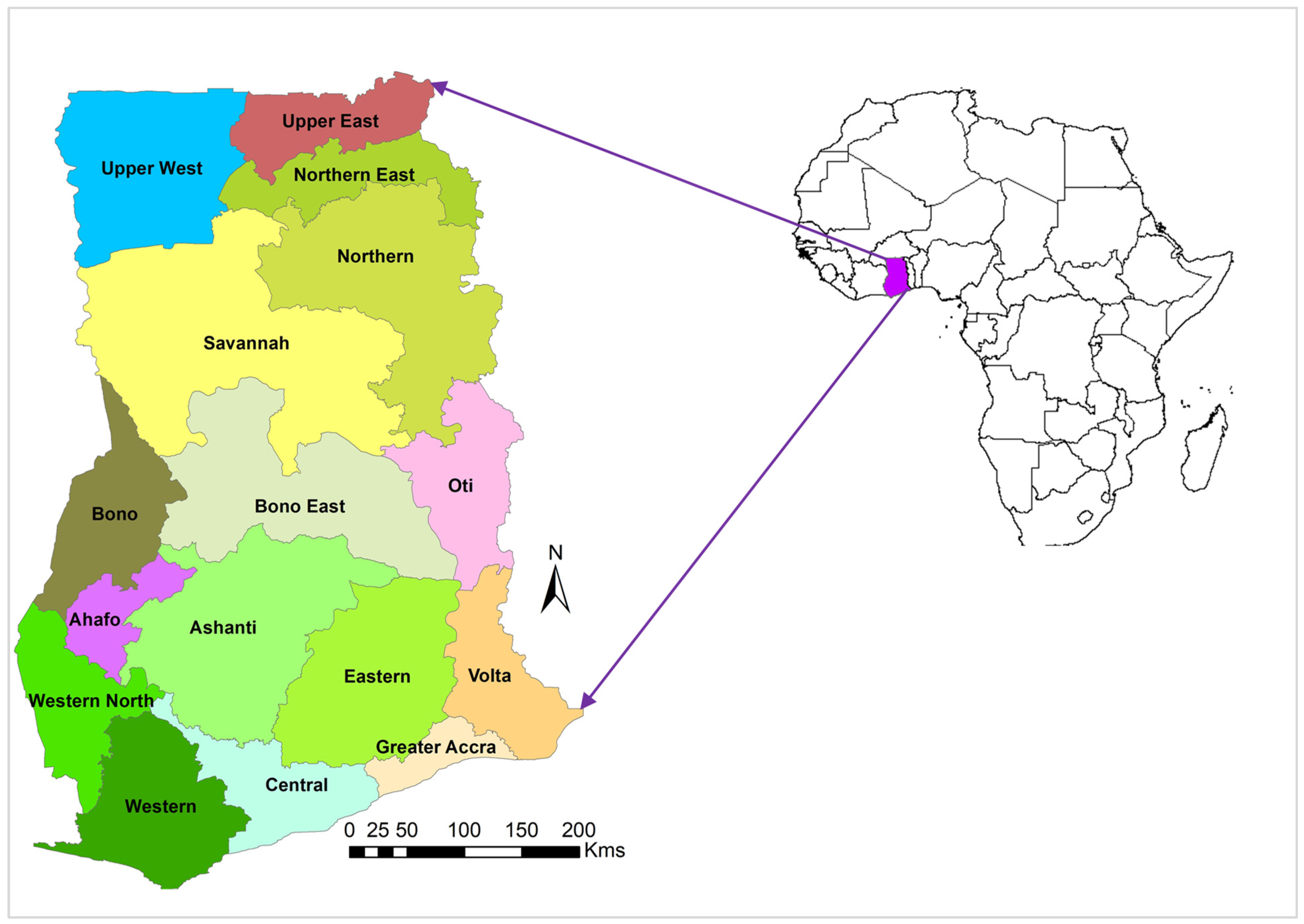

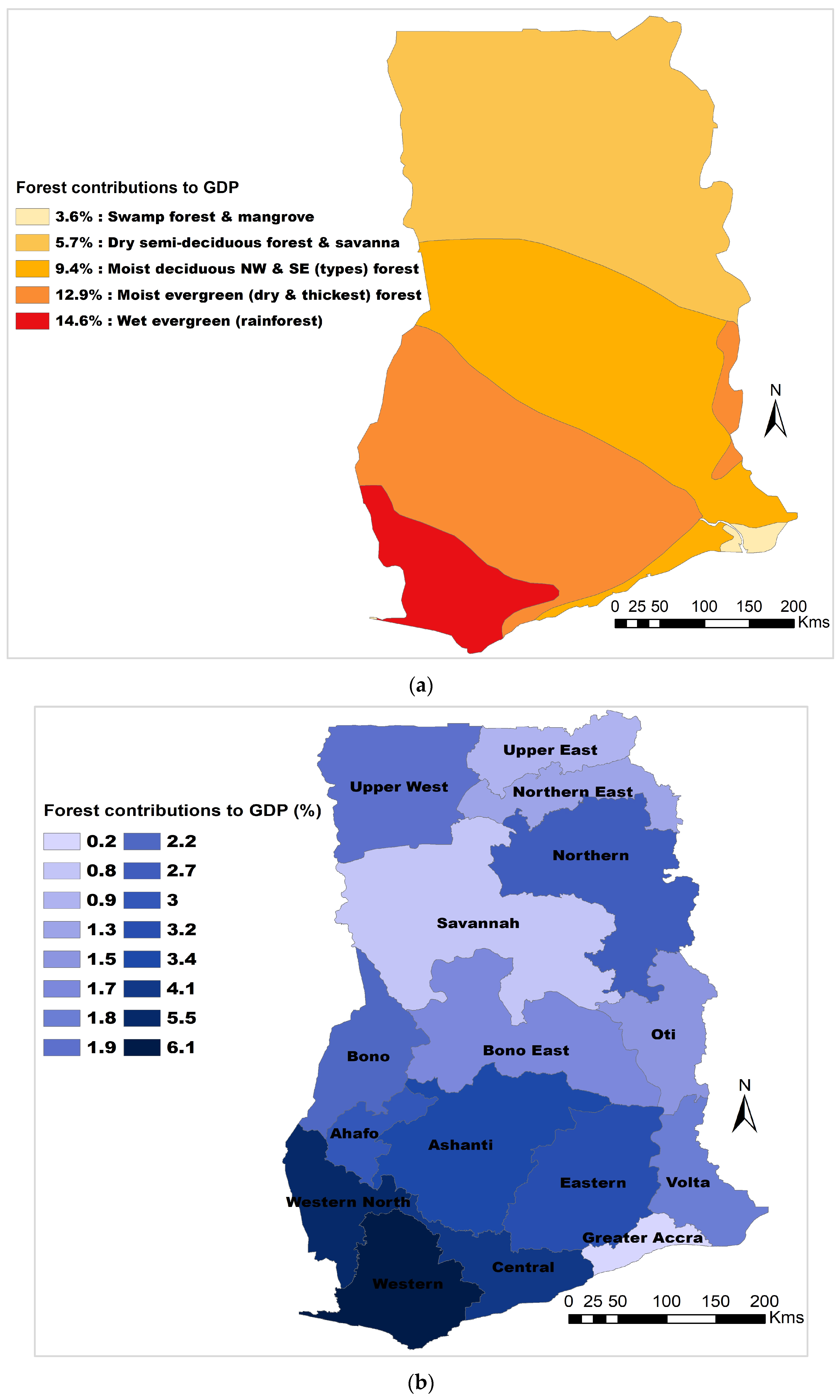

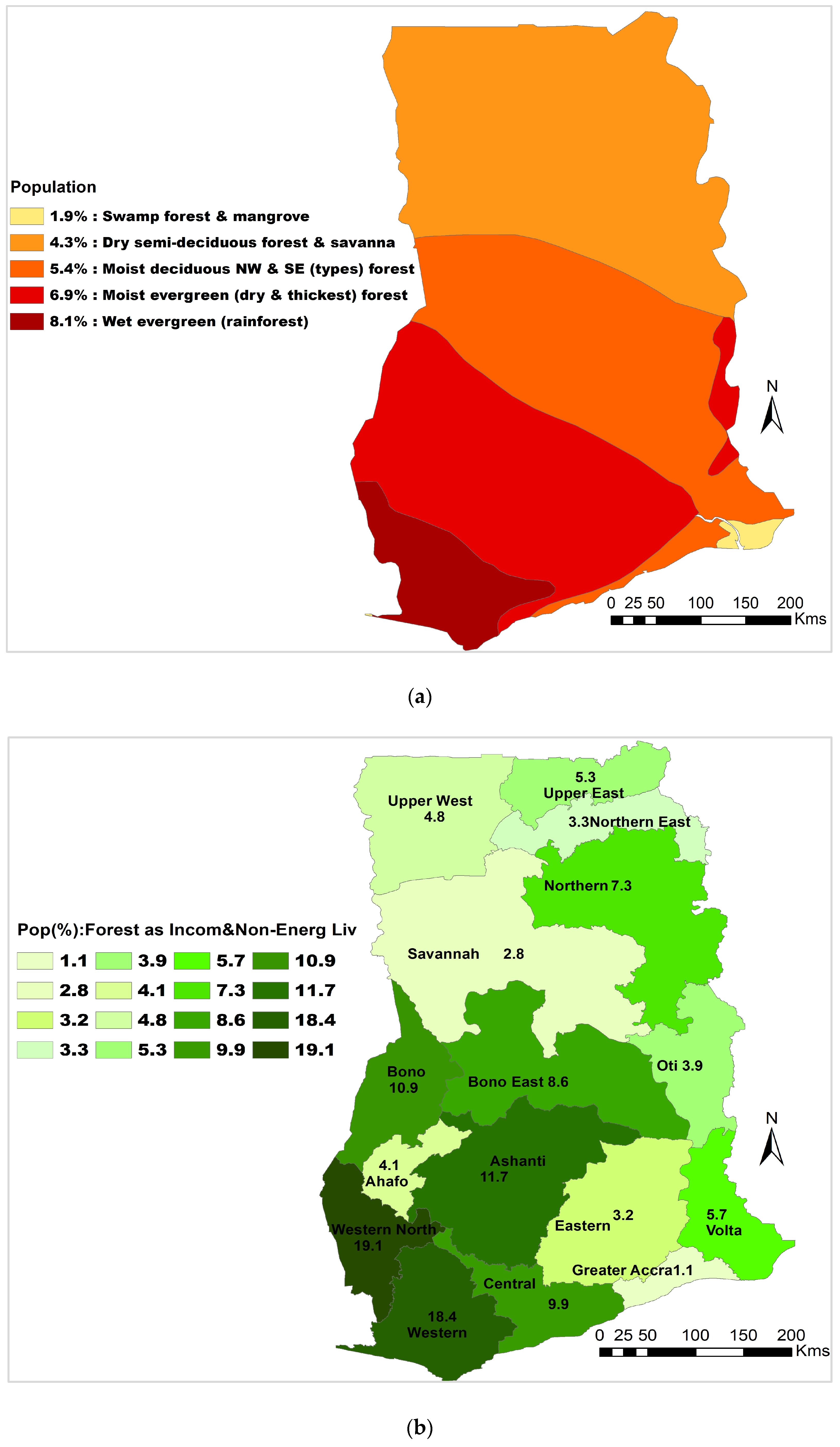
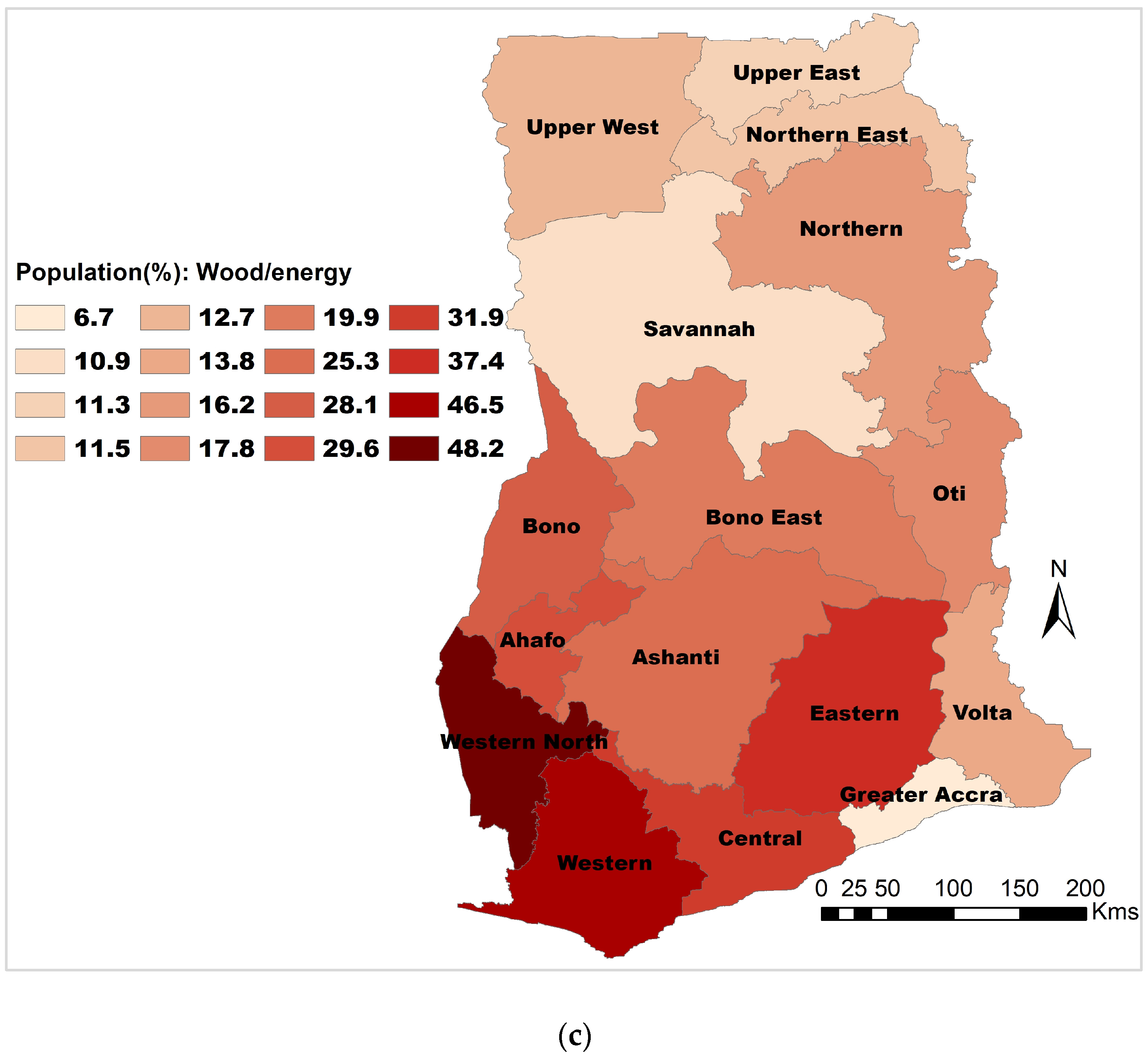


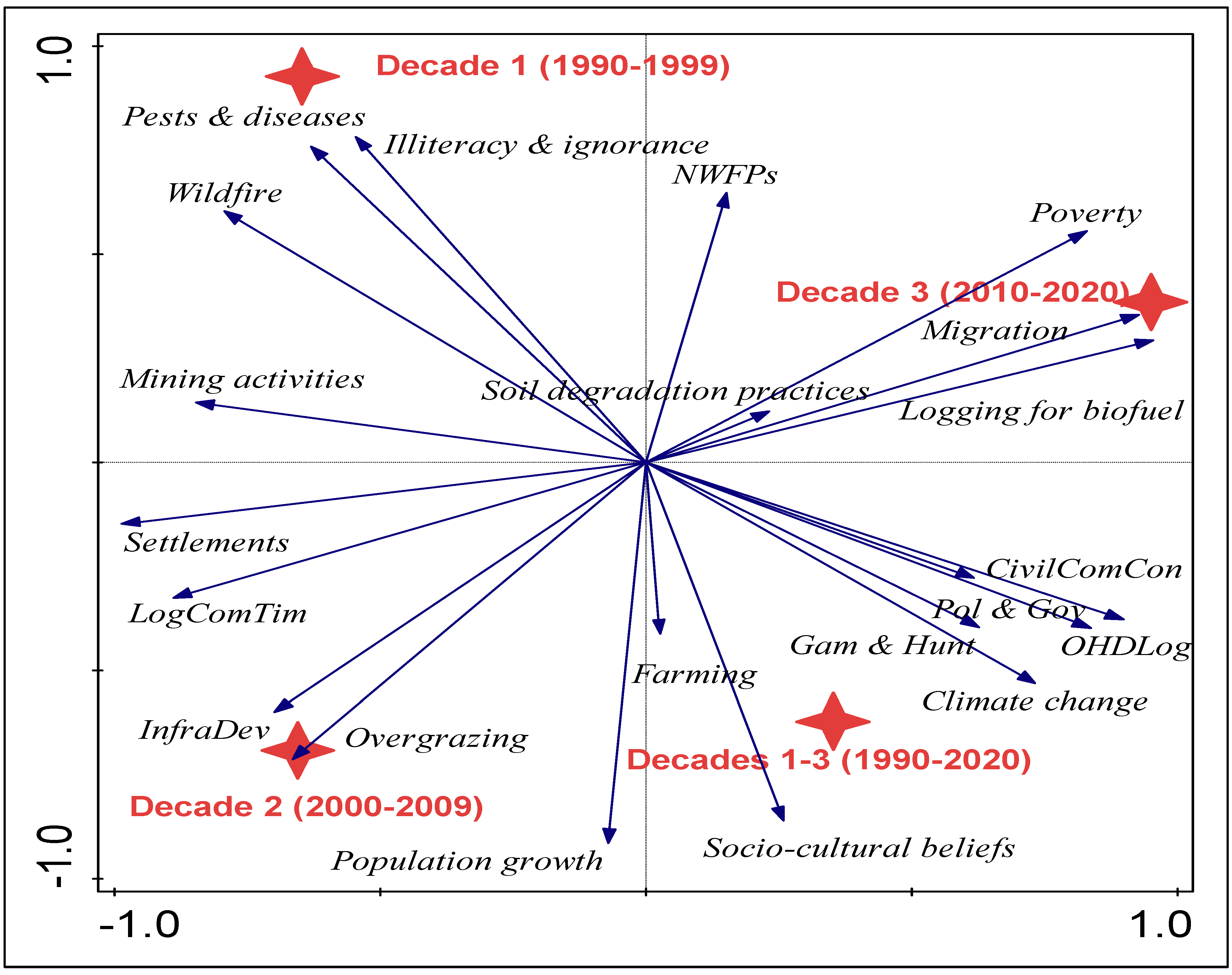

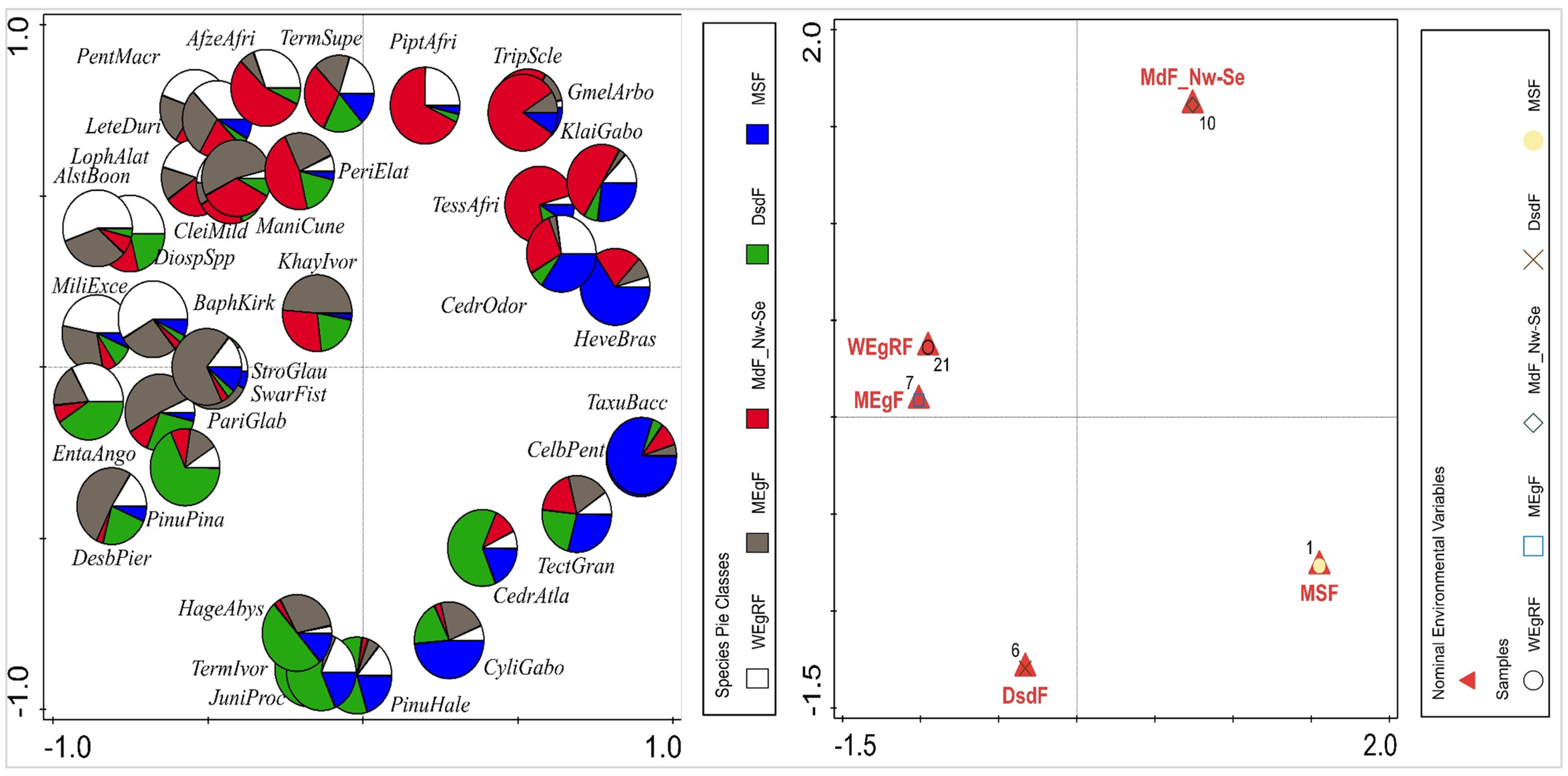
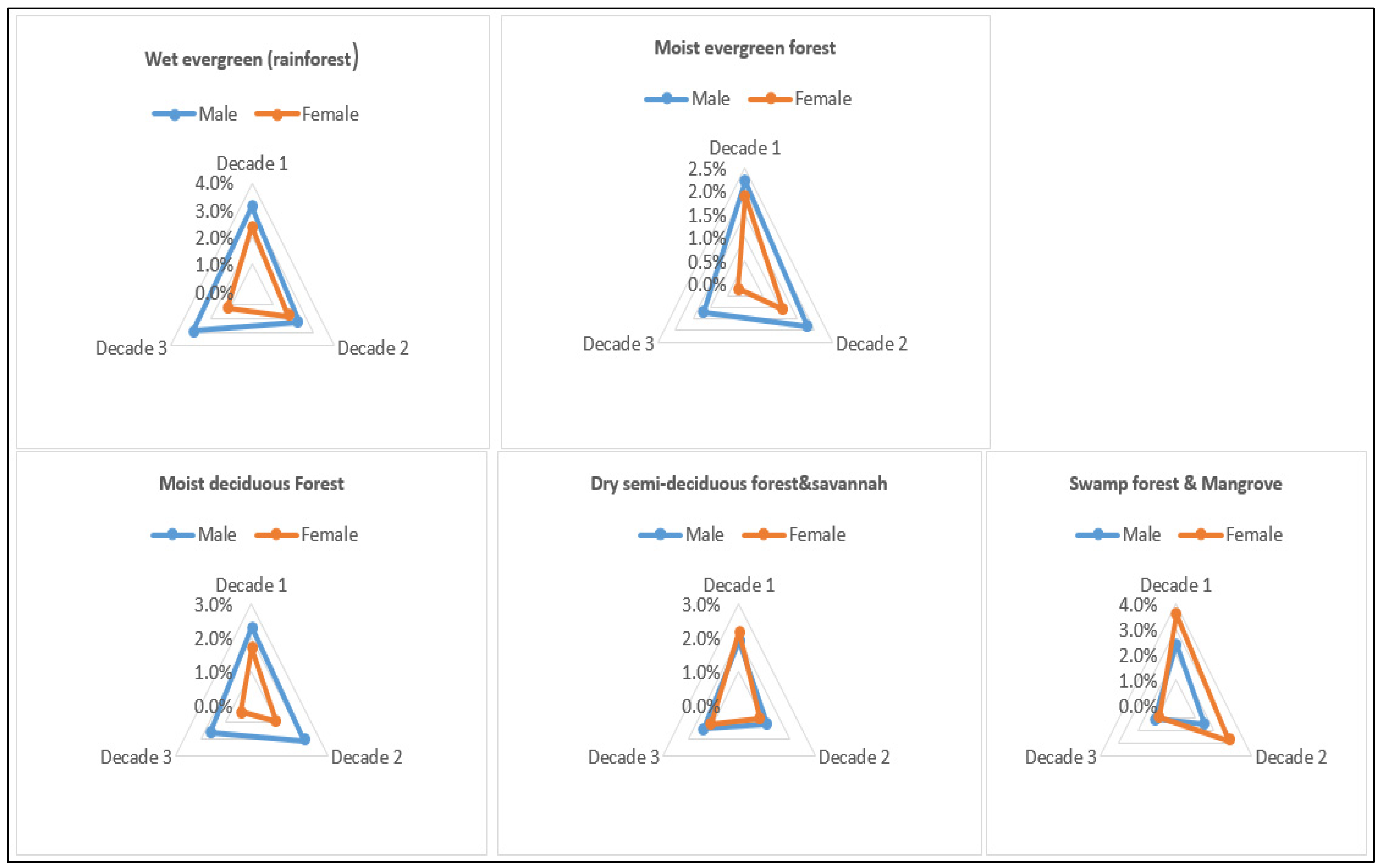
| Indicator/Measure | Sources |
|---|---|
| Administrative regions | Global coordinates https://data.humdata.org/dataset/cod-ab-gha; |
| Forest–vegetation belts | -www.omap.africanmarineatlas.org (accessed on 7 January 2023) |
| Sampling points | - Field sampling and survey, hand-held GPS. |
| Land use-cover and changes, 1990–2020 | - Digital and satellite imageries from https://eros.usgs.gov/westafrica/land-cover/land-use-and-land-cover-trends-west-Africa (accessed on 8 January 2023); - www.nasa.gov (accessed on 8 January 2023). |
| Forest areas and loss, 1990–2020 | - FAO’s Global Forest Resources Assessments Reports |
| Forest tree cover and loss, 1990–2020 | - FAO’s Global Forest Resources Assessments Reports |
| Forest growing stocks, 1990–2020 | - FAO’s Global Forest Resources Assessments (main and country reports) |
| Contributions of forest to GDP, 1990–2020 | - Ghana Statistical Services database - World Bank websites |
| Country’s GDP, rates of illiteracy, poverty, and infrastructural development | - Ghana Statistical Services database - World Bank websites - Other reports and documents |
| Uses of forests: farming, mining, bioenergy, timber, NWFPs, etc. | - Ghana Statistical Services database - World Bank websites - Reports of Timber Industry Development Division - Forestry Commission. - Other reports and documents |
| Biophysical: climate, wildfire, soil, net primary productivity (NPP), pests and diseases, carbon emissions | - Ministry of Food and Agriculture database - Forestry Commission - Energy Commission - Published literature - FAOSTATS websites - ISRIC Soil geographic databases: https://www.isric.org/explore/soil-geographic-databases (accessed on 15 December 2022) - Moderate resolution imaging Spectroradiometer (MODIS) on NASA’s Terra satellite: https://neo.gsfc.nasa.gov/ (accessed on 27 December 2022) |
| Population and settlement, 1990–2020 | - Ghana statistical services database |
| Forest-based employment, migration, civil/communal conflicts | - Ghana statistical services database - Other published literature |
| Drivers of deforestation, socio-cultural and political views, and stands on deforestation | - Field sampling and survey (online and physical) using literature, interviews, questionnaires |
| Common forest tree species | - Field sampling and survey |
| - Past literature (published articles and NGOs/government institutional documents) | |
| - Foresters and plant ecologists |
| Group/Class of Drivers | Current Drivers of Deforestation | Interviews: % (no.) of Experts (n = 15) Who Endorsed the Driver | Interviews: % (no.) of Farmers and Foresters (n = 30) Who Mentioned the Driver | Literature: % (no.) of Authors (n = 25) Who Indicated the Driver |
|---|---|---|---|---|
| Direct driver: anthropogenic or human | Population growth (rural and urban) | 100% (15) | 100% (30) | 100% (25) |
| Agricultural intensification (modern and conventional) | 100% (15) | 90% (27) | 84% (21) | |
| Use of forest for biofuel | 80% (12) | 73% (22) | 80% (20) | |
| Use of forest for timber | 100% (15) | 100% (30) | 100% (25) | |
| Use of forest for NWFPs | 53% (8) | 57% (17) | 52% (13) | |
| Construction and building (settlements, canoes, etc.) | 60% (9) | 63% (19) | 64% (16) | |
| Mining | 87% (13) | 90% (27) | 92% (23) | |
| Wildfire | 53% (8) | 50% (15) | 52% (13) | |
| Overgrazing/livestock | 60% (9) | 53% (16) | 56% (14) | |
| Wildlife (game and hunting) | 53% (8) | 50% (15) | 52% (13) | |
| Infrastructural development (road, schools, markets, hospitals, etc.) | 53% (8) | 57% (17) | 56% (14) | |
| Direct driver: biophysical | Soil quality (e.g., degradation, SOM) | 67% (10) | 60% (18) | 60% (15) |
| Topography | 33% (5) | 27% (8) | 24% (6) | |
| Rainfall variability | 73% (11) | 67% (20) | 68% (17) | |
| Temperature variability | 60% (9) | 53% (16) | 56% (14) | |
| Wind intensity | 47% (7) | 53% (16) | 48% (12) | |
| Pests and diseases | 53% (8) | 50% (15) | 52% (13) | |
| Indirect driver: socio-cultural and economic | Civil/communual conflicts | 53% (8) | 50% (15) | 52% (13) |
| Migration | 53% (8) | 57% (17) | 56% (14) | |
| Religious beliefs and patterns | 13% (2) | 20% (6) | 28% (7) | |
| Cultural/traditional beliefs | 60% (9) | 70% (21) | 72% (18) | |
| Illiteracy rate (level of education) | 53% (8) | 77% (23) | 68% (17) | |
| Land tenure system | 20% (3) | 23% (7) | 16% (4) | |
| Poverty rate (e.g., Rising living standard) | 93% (14) | 100% (30) | 96% (24) | |
| Rural farmers lack of capital | 27% (4) | 17% (5) | 12% (3) | |
| Foreign agricultural medium-scale investments | 0% (0) | 3% (1) | 0% (0) | |
| International funding/development aid | 0% (0) | 0% (0) | 0% (0) | |
| Credits by family, bank, government, or NGO | 6% (1) | 10% (3) | 4% (1) | |
| Labour shortage | 13% (2) | 6% (2) | 8% (2) | |
| Political/governance | Unsound policies | 60% (9) | 77% (23) | 52% (13) |
| Weak governance | 53% (8) | 60% (18) | 72% (18) | |
| Lack of law enforcements | 73% (11) | 73% (22) | 56% (14) | |
| Landlessness | 53% (8) | 70% (21) | 52% (13) | |
| Unclear allocation of rights | 53% (8) | 63% (19) | 56% (14) | |
| Impoverishments of the rural people | 87% (13) | 80% (24) | 68% (17) | |
| Lack of investments and financial resources | 67% (10) | 86% (26) | 72% (18) | |
| National agricultural programmes | 13% (2) | 13% (4) | 12% (3) | |
| Fertilizer subsidies | 6% (1) | 10% (3) | 8% (2) |
| Dead Wood | For Prot Area | Pop | For CoGDP | GDP Gro | For GroStok | For Area | For Loss | Tree CovLoss | Pov Rate | For Biofuel | For NonBiofuel | Rain Fall | Temp | SOM | NPP | |
|---|---|---|---|---|---|---|---|---|---|---|---|---|---|---|---|---|
| Dead Wood | 1.00 | |||||||||||||||
| ForProtArea | 0.86 * | 1.00 | ||||||||||||||
| Pop | −0.97 ** | −0.93 * | 1.00 | |||||||||||||
| ForCoGDP | 0.73 | 0.70 | −0.76 * | 1.00 | ||||||||||||
| GDPGro | 0.39 | 0.28 | −0.37 * | 0.45 | 1.00 | |||||||||||
| ForGroStok | 0.99 * | 0.86 | −0.98 * | 0.75 * | 0.41 | 1.00 | ||||||||||
| ForArea | 0.92 * | 0.90 * | −0.91 * | 0.66 * | 0.34 | 0.91 * | 1.00 | |||||||||
| ForLoss | −0.77 * | −0.61 | 0.78 * | −0.55 * | −0.32 | −0.77 * | −0.60 * | 1.00 | ||||||||
| TreeCovLoss | −0.95 * | −0.78 | 0.92 * | −0.66 | −0.34 | −0.94 * | −0.84 * | 0.83 | 1.00 | |||||||
| PovRate | 0.6 1 ** | 0.71 ** | −0.63 ** | 0.33 | −0.51 * | 0.62 * | 0.62 * | −0.47 * | −0.55 | 1.00 | ||||||
| ForBiofuel | −0.86 * | −0.90 * | 0.89 ** | −0.71 * | −0.32 | −0.86 * | −0.88 * | 0.55 * | 0.62 * | −0.58 * | 1.00 | |||||
| ForNonBiofuel | −0.86 | −0.84 | 0.88 ** | −0.65 | −0.28 | −0.83 * | −0.79 * | 0.66 | 0.79 | −0.60 * | 0.77 | 1.00 | ||||
| Rainfall | 0.61 * | 0.07 | 0.00 | 0.18 | 0.00 | 0.55 * | 0.51 * | 0.23 | 0.00 | 0.00 | −0.03 | 0.00 | 1.00 | |||
| Temp | 0.57 * | 0.00 | 0.00 | 0.01 | 0.00 | 0.48 * | 0.36 * | 0.00 | 0.00 | 0.00 | 0.09 | 0.00 | 0.51 | 1.00 | ||
| SOM | 0.95 * | 0.87 * | −0.96 * | 0.69 * | 0.36 | 0.95 ** | 0.89 * | −0.80 * | −0.91 | 0.64 | −0.82 * | −0.89 | 0.44 | −0.32 | 1.00 | |
| NPP | 0.96 * | 0.70 | −0.98 * | 0.73 * | 0.34 | 0.86 ** | 0.91 * | −0.71 * | −0.90 | 0.64 | −0.91 | −0.87 * | 0.50 | 0.57 * | 0.94 * | 1.00 |
Disclaimer/Publisher’s Note: The statements, opinions and data contained in all publications are solely those of the individual author(s) and contributor(s) and not of MDPI and/or the editor(s). MDPI and/or the editor(s) disclaim responsibility for any injury to people or property resulting from any ideas, methods, instructions or products referred to in the content. |
© 2023 by the authors. Licensee MDPI, Basel, Switzerland. This article is an open access article distributed under the terms and conditions of the Creative Commons Attribution (CC BY) license (https://creativecommons.org/licenses/by/4.0/).
Share and Cite
Nyarko, I.; Nwaogu, C.; Miroslav, H. Forest Bioeconomy in Ghana: Understanding the Potential Indicators for Its Sustainable Development. Forests 2023, 14, 804. https://doi.org/10.3390/f14040804
Nyarko I, Nwaogu C, Miroslav H. Forest Bioeconomy in Ghana: Understanding the Potential Indicators for Its Sustainable Development. Forests. 2023; 14(4):804. https://doi.org/10.3390/f14040804
Chicago/Turabian StyleNyarko, Isaac, Chukwudi Nwaogu, and Hájek Miroslav. 2023. "Forest Bioeconomy in Ghana: Understanding the Potential Indicators for Its Sustainable Development" Forests 14, no. 4: 804. https://doi.org/10.3390/f14040804
APA StyleNyarko, I., Nwaogu, C., & Miroslav, H. (2023). Forest Bioeconomy in Ghana: Understanding the Potential Indicators for Its Sustainable Development. Forests, 14(4), 804. https://doi.org/10.3390/f14040804







